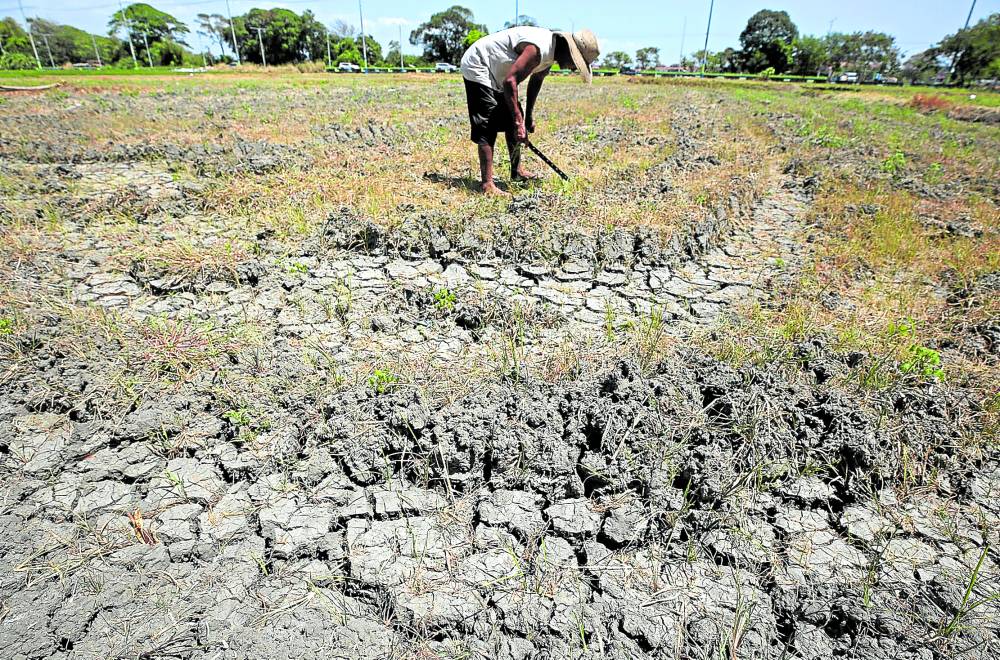
Photo shows a drought-hit farm in Imus, Cavite, taken on March 2, 2024. —RICHARD A. REYES
The widespread drought caused by the El Niño weather phenomenon since the start of the year forced many farmers out of work, raising the country’s unemployment rate in April to 4 percent from 3.9 percent the previous month, the Philippine Statistics Authority (PSA) reported on Thursday.
This translated to 2.04 million unemployed Filipinos, higher than the 2 million who were jobless in March.
Preliminary results of the statistics agency’s Labor Force Survey (LFS) for April showed the unemployment rate was the highest in three months, but lower than the 4.5 percent in April 2023 and January this year.
National Statistician Dennis Mapa said job losses were observed in the agriculture sector, mainly among the crop farm laborers, which mirrored the lower agricultural production in the first quarter.
READ: April unemployment rate at 4%, up from 3.9% in March
For April, agriculture and forestry had the biggest job losses at 818,000 workers, followed by wholesale and retail with a decline of 587,000 workers.
The Department of Agriculture (DA) last month reported that the damage caused by the El Niño phenomenon had already reached P6.3 billion, with the rice sector accounting for P3.3 billion, corn at P1.9 billion and high-value commercial crops at P1 billion.
The highest reported damage was in Mimaropa (Mindoro, Marinduque, Romblon and Palawan) with P1.7 billion, followed by Western Visayas with P1.5 billion, and the Cordillera Administrative Region with almost P800 million.
The DA noted that 60,000 hectares of land were damaged by the El Niño so far, or half of the 120,000 hectares projected by the agency.
Insufficient wages
The underemployment rate—the share in the total employed population of those already working but still looking for more work or longer working hours—also worsened to 14.6 percent in April from 11 percent in the previous month.
This meant that 7.04 million Filipinos were looking for additional jobs or overtime work to increase their income.
Underemployment in April was the highest since the 15.9 percent recorded in July 2023.
For Josua Mata, secretary general of the labor coalition Sentro ng mga Nagkakaisa at Progresibong Manggagawa, the slowdown in job creation proved that job programs implemented by the government failed to deliver the decent jobs that workers deserved, as reflected in the underemployment record in April.
Mata also expressed concern, as challenges brought by the La Niña weather phenomenon, which is characterized by increased rainfall, were expected to affect the labor market in the coming months.
“Unless the government rolls out a robust public employment program immediately, unemployment could easily exceed the government’s target of 3 to 4 percent by year-end,” Mata said.
Job-creation plan
National Economic and Development Authority (Neda) Secretary Arsenio Balisacan said the government remained committed to job creation by investing in human capital and pushing for stronger industries and infrastructure development.
“The government’s massive infrastructure push is expected to create opportunities in several priority sectors, such as energy, logistics, and tourism. The government will also explore opportunities for quality job growth in the mining sector, leveraging available technologies to develop value-adding activities such as mineral processing,” Balisacan said in a statement.
President Marcos earlier signed Executive Order No. 59, which aims to expedite the implementation of the administration’s infrastructure flagship projects and improve the ease of doing business.
This is expected to further encourage investments and job creation in the country, Balisacan said.
“The government is currently drafting the Trabaho Para sa Bayan (TPB) Plan, which will serve as the country’s comprehensive employment generation and recovery master plan. It aims to address unemployment, underemployment, informal working arrangements, and other labor market challenges,” Balisacan added.
He said the TPB would focus on enhancing the employability and competitiveness of Filipino workers through upskilling and reskilling initiatives, pointing out that support for micro, small, and medium enterprises and industry stakeholders was also integral to the plan.
“The government aims to assist Filipino workers in the digital age. Initiatives include reducing job search duration, upskilling the workforce, and facilitating the transition towards higher-income jobs. The urgent passage of next-generation reforms, including the Konektadong Pinoy bill, will play a crucial role in opening up more work opportunities and developing digital skills among the workforce,” Balisacan said.
Services top employer
The proportion of the total labor in the working-age population of 15 years old and over—or the labor force participation rate (LFPR)—fell to 64.1 percent in April from 65.3 percent in the previous month.
Likewise, the employment rate went down to 96 percent from 96.1 percent in March, also the lowest in three months.
There were 48.36 million employed Filipinos in April, higher than 48.06 million in April 2023.
By broad industry group, the services sector remained the top sector in terms of the number of employed persons, with a share of 61.4 percent of the 48.36 million employed Filipinos.
The agriculture and industry sectors accounted for 20.3 percent and 18.3 percent, respectively.